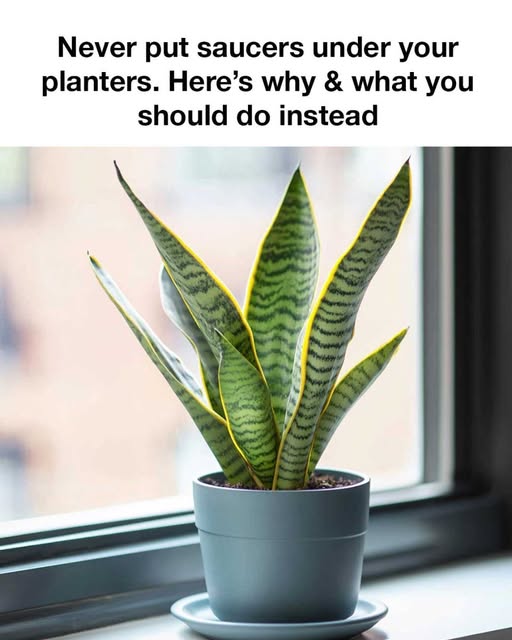Planter saucers are commonly used as a practical accessory for indoor and outdoor plants. They are typically placed underneath planters to catch excess water that drains out after watering. The idea is to prevent water from spilling onto floors or surfaces, thus keeping the area clean and dry. Saucers come in various materials such as plastic, ceramic, and metal, and are often chosen to match the aesthetic of the planter. While they may seem like a convenient solution, their use can lead to several issues that can negatively impact plant health and home maintenance.
The Problems with Using Saucers Under Planters
Using saucers under planters can create a host of problems that many plant enthusiasts might not initially consider. These issues range from plant health concerns to potential damage to home surfaces. Saucers can trap water, leading to overwatering and root rot, attract pests and mold, cause water damage to furniture or floors, and restrict airflow and drainage. Understanding these problems can help plant owners make more informed decisions about how to care for their plants effectively.
Reason 1: Risk of Overwatering and Root Rot
One of the primary risks of using saucers is the potential for overwatering. When water collects in the saucer, it can create a consistently moist environment that prevents the soil from drying out properly. This can lead to root rot, a condition where the plant’s roots begin to decay due to excessive moisture. Root rot is often fatal to plants, as it impairs their ability to absorb nutrients and water.
Overwatering is one of the most common mistakes made by plant owners, and it is often exacerbated by saucers. When excess water is not allowed to drain away, it can create a stagnant pool beneath the pot, which increases the chances of root rot. To avoid this, it is crucial to ensure that planters have proper drainage and that excess water is not left standing in saucers. Even if the saucer catches excess water, it is essential to remove it shortly after watering. Leaving water in a saucer for prolonged periods can turn your plant’s root system into a breeding ground for harmful bacteria and fungi.
Root rot can be devastating for plants, leading to yellowing leaves, wilting, and stunted growth. It’s important to know the signs of root rot early, such as a foul smell or blackened roots, so that you can address the problem before it’s too late.
Reason 2: Attraction of Pests and Mold Growth
Standing water in saucers can attract pests such as mosquitoes, gnats, and other insects that thrive in moist environments. Additionally, the damp conditions can promote the growth of mold and mildew, which can spread to the plant and surrounding areas. Mold not only poses a risk to plant health but can also be a concern for human health, especially for those with allergies or respiratory issues. Keeping the area dry and well-ventilated is essential to prevent these problems.
Gnats and other pests are often attracted to the moist conditions created by waterlogged saucers. These pests are particularly problematic in the soil of your plants, where they can lay eggs and infest the root zone. Fungus gnats, for example, can damage plant roots and disrupt their ability to take up water and nutrients.
Mold growth is another common issue associated with stagnant water. It thrives in warm, humid environments, and a saucer that collects excess water is the perfect breeding ground. Mold can spread to the soil and the surface of the pot, potentially infecting the plant. If the mold begins to spread to other areas of your home, it could create further health hazards for you and your family. Regularly cleaning your planters and ensuring good air circulation will help prevent these pests and mold from taking hold.
Reason 3: Potential for Water Damage to Surfaces
Saucers can overflow or leak, leading to water damage on floors, carpets, or furniture. This is particularly problematic for wood surfaces, which can warp or stain when exposed to water. Even with a saucer, water can seep through cracks or overflow during heavy watering, causing damage that may be costly to repair.
If you’ve ever noticed the faint rings or watermarks left behind by a saucer, you know the risk of water damage is very real. Wooden floors are particularly susceptible to warping and discoloration when exposed to moisture. Additionally, fabric furniture and rugs can absorb water, leading to stains or even mold growth if not properly dried.
The best way to avoid water damage is to remove any excess water from the saucer immediately after watering. You can also consider placing a waterproof mat under the saucer for extra protection, though this does not eliminate the root cause of the problem – stagnant water.
Reason 4: Limitation of Airflow and Drainage
Saucers can restrict airflow around the base of the planter, which is essential for healthy root development. Proper airflow helps the soil dry out between waterings, reducing the risk of fungal growth and promoting a healthy root system. Additionally, saucers can impede drainage, especially if they are not emptied regularly. Ensuring that planters have adequate drainage holes and are elevated to allow air circulation can help maintain plant health.
Roots need to breathe. When water sits in a saucer, it can create a barrier that prevents air from circulating freely around the base of the planter. This reduced airflow contributes to root stress, poor oxygenation, and the development of conditions like root rot. Moreover, the lack of proper drainage from the saucer further exacerbates the problem. Elevating your planter and ensuring that it is draining properly is key to healthy plant growth.
Alternative Solutions to Using Saucers
Instead of using saucers, consider alternative solutions that promote better drainage and airflow. One popular method is using a pebble tray, which elevates the planter and allows water to drain away from the roots. Other options include using self-watering planters, which regulate moisture levels more effectively, or placing planters on plant stands to improve air circulation.
How to Use a Pebble Tray for Planters
A pebble tray is a simple and effective way to improve drainage for indoor plants. To create a pebble tray, select a shallow tray that is larger than the base of your planter. Fill the tray with a layer of small stones or pebbles, then add water until it reaches just below the top of the pebbles. Place the planter on top of the pebbles, ensuring that the bottom of the pot is not submerged in water. This setup allows excess water to drain away from the roots while maintaining humidity around the plant.
The pebble tray method works by elevating the planter above the standing water, preventing the roots from sitting in stagnant moisture. The pebbles provide support and create space for air to circulate around the base of the pot, while the water in the tray increases the humidity in the surrounding environment. This method works particularly well for tropical plants that thrive in high humidity. However, make sure that the water level in the tray never submerges the pebbles, as this could still lead to waterlogging.
Additional Ideas for Improving Plant Drainage
In addition to using pebble trays, there are several other strategies to enhance plant drainage. Ensure that planters have adequate drainage holes and consider adding a layer of gravel or coarse sand at the bottom of the pot to improve drainage. Using well-draining soil mixes, such as those containing perlite or vermiculite, can also help prevent waterlogging. Regularly checking and adjusting watering schedules based on the plant’s needs and environmental conditions is crucial for maintaining optimal moisture levels.
By adding a layer of gravel or sand to the bottom of your pot, you help create a space where excess water can flow away from the roots. Similarly, using well-draining soil allows moisture to flow freely through the pot, which helps prevent water from accumulating around the roots. Ensure that you are watering your plants according to their specific needs, as some plants require more frequent watering than others.
Conclusion: Best Practices for Healthy Plant Care
For healthy plant care, it is essential to prioritize proper drainage and airflow. Avoiding the use of saucers under planters can help prevent common issues such as overwatering, pest attraction, and surface damage. Instead, explore alternative methods like pebble trays, self-watering planters, and plant stands to create an environment that supports plant health. By understanding the needs of your plants and adjusting care practices accordingly, you can ensure that your indoor garden thrives.
When it comes to plant care, small adjustments can make a significant difference. By reconsidering the use of saucers and implementing better drainage strategies, you can avoid the pitfalls of overwatering, pest infestations, and water damage. As a result, your plants will flourish in a healthier, more sustainable environment, and your home will remain free from the hassles and risks associated with using traditional saucers. Happy planting!

